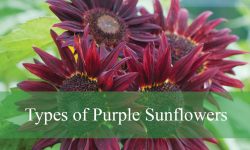Florida’s warm, tropical climate supports a wide range of vibrant and unique plant life, but not all of it is harmless. Many common plants found in gardens, parks, and wild areas across the state contain toxic compounds that can be dangerous to humans and animals. Recognizing these hazardous species is important for safety and awareness.
This article highlights 10 of the most common poisonous plants in Florida, with clear pictures and detailed information about their appearance, toxic effects, and typical habitats. These plants may look beautiful or harmless but can cause serious health issues if touched or ingested.
Learning to identify poisonous plants in Florida can help prevent accidental contact, especially for families with children or pets. Understanding their warning signs and where they’re found is a simple step toward enjoying Florida’s natural beauty more safely.
Different Types of Poisonous Plants in Florida
Here’s a list of common poisonous plants in Florida, including those dangerous to humans, pets, or livestock. Many of these can be found in gardens, forests, parks, or even growing wild.
Oleander (Nerium oleander)
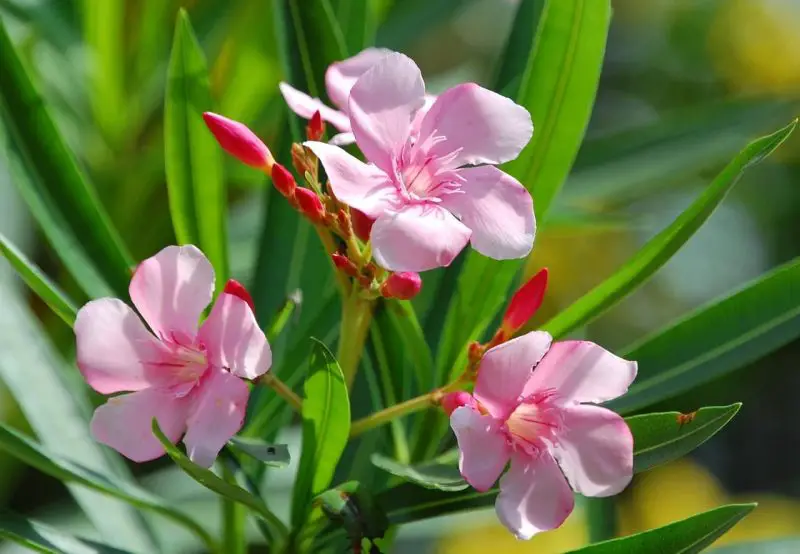
Oleander is an evergreen shrub or small tree known for its dense foliage and clusters of showy, funnel-shaped flowers in pink, white, red, or yellow. It typically grows 6 to 12 feet tall and is widely used in Florida landscaping due to its drought resistance and ability to thrive in poor soils. Despite its ornamental appeal, it is one of the most poisonous plants found in the state. Its attractive appearance often leads people to underestimate its potential danger.
Identification of oleander is straightforward thanks to its leathery, dark green leaves that are arranged in pairs or whorls of three along the stem. The leaves are long, narrow, and pointed, giving the plant a sharp, clean look. Its flowers bloom from spring through fall and emit a light fragrance. The plant can form dense hedges or grow as an individual specimen, commonly lining highways and gardens throughout Florida.
All parts of the oleander plant contain potent cardiac glycosides, including oleandrin and neriine. These compounds interfere with the body’s electrolyte balance and directly affect heart function. Ingesting even a small amount can lead to serious symptoms such as nausea, vomiting, irregular heartbeat, seizures, and potentially death. Even smoke from burning oleander can be toxic when inhaled.
Oleander is highly dangerous to both humans and animals. Children and pets are particularly at risk due to their lower body weight. Accidental ingestion of leaves, flowers, or even contaminated water can be fatal. Despite its toxicity, its use in public landscaping continues, making public education about its dangers especially important in Florida.
Rosary Pea (Abrus precatorius)

Rosary pea is a slender, climbing vine recognized by its striking red seeds, each with a glossy black spot. These seeds are often used in jewelry and rosaries, hence the name. Native to tropical and subtropical regions, this plant is now naturalized in many parts of Florida, particularly in disturbed sites such as roadsides, fences, and fields. Although the plant may seem harmless, it harbors one of the most deadly natural toxins known to science.
The plant has compound leaves with numerous small leaflets and delicate purple to pink flowers that resemble those of the pea family. It twines around trees and shrubs using thin, wiry stems. While its vegetative parts are not highly toxic, the seeds are extremely dangerous. The seeds are hard and often need to be broken or chewed to release their toxin, which is why intact seeds may pass through the body without causing harm.
Rosary pea contains abrin, a highly potent toxin that inhibits protein synthesis in cells. It is structurally similar to ricin but is estimated to be even more toxic. As little as one thoroughly chewed seed can be fatal to an adult. Symptoms of poisoning include vomiting, abdominal pain, liver failure, convulsions, and eventually death if untreated. There is no known antidote, and treatment is supportive only.
The danger posed by this plant is increased by the fact that its seeds are attractive and often handled without awareness of their toxicity. In Florida, rosary pea is classified as an invasive species, and its spread is actively managed. It poses a threat to native ecosystems and human health, especially if the seeds are used in crafts or swallowed accidentally.
Angel’s Trumpet (Brugmansia spp.)
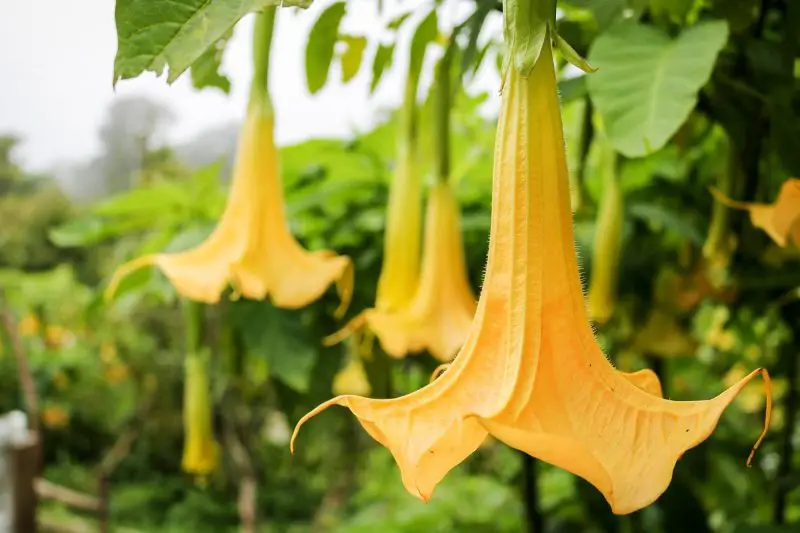
Angel’s Trumpet is a tropical ornamental plant known for its large, pendulous flowers that resemble trumpets, which can be white, pink, orange, or yellow. The plant can grow as a shrub or small tree, reaching up to 15 feet in height. It is widely cultivated in Florida for its dramatic appearance and fragrant nighttime blooms. Despite its beauty, every part of this plant is highly toxic.
The leaves of Angel’s Trumpet are large, broad, and often have a fuzzy texture. The flowers can be over 12 inches long and hang downward, releasing a strong scent, especially in the evening. It is a favorite in tropical-style gardens and is often grown in containers or as a landscape focal point. Its dramatic form makes it a frequent attraction, but also a hidden hazard.
Angel’s Trumpet contains several dangerous alkaloids, including scopolamine, hyoscyamine, and atropine. These compounds affect the nervous system and can cause symptoms such as dilated pupils, hallucinations, dry mouth, confusion, seizures, and even death. Ingesting the plant, smoking it, or using it for recreational purposes can result in severe poisoning. It has a history of misuse in traditional medicine and rituals, which has led to accidental poisonings.
In Florida, Angel’s Trumpet is commonly found in warm regions and maintained by home gardeners and plant enthusiasts. It is essential to keep it out of reach of children and pets. Even touching the plant and then rubbing the eyes can cause symptoms due to the presence of alkaloids on the skin. Its popularity in ornamental horticulture must be weighed against its serious health risks.
Poison Ivy (Toxicodendron radicans)
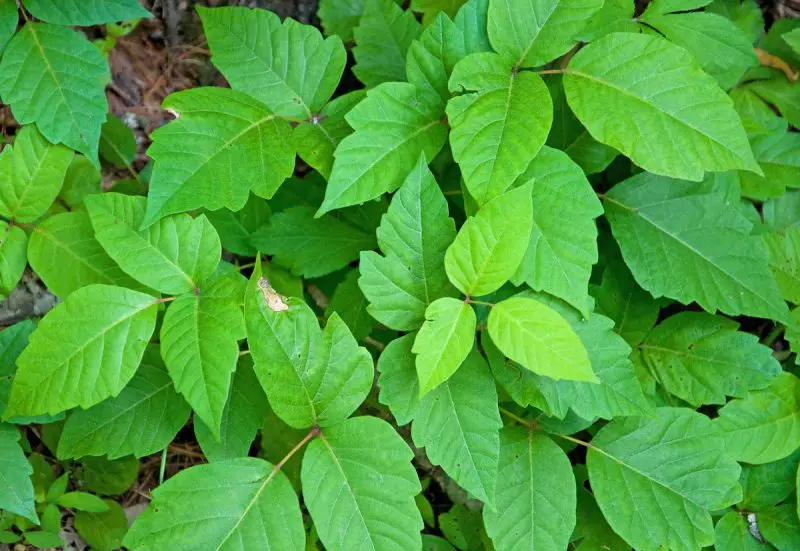
Poison Ivy is a native plant that is infamous for causing skin irritation upon contact. It typically grows as a climbing vine or ground-covering shrub and is widespread throughout Florida’s wooded areas, trails, and brushy habitats. Its ability to thrive in both sun and shade makes it a common sight in suburban and natural environments. It is especially dangerous to those who come into contact with it unknowingly.
The plant is easily identified by its characteristic compound leaves made up of three pointed leaflets—a feature that has led to the well-known saying, “Leaves of three, let it be.” The leaves are green in spring and summer, often turning red or orange in fall. Poison Ivy produces small white or greenish berries that attract birds but are not safe for humans. Its vines often have hairy-looking aerial roots that attach to trees and structures.
The primary irritant in Poison Ivy is urushiol, an oily resin found in the plant’s leaves, stems, and roots. When urushiol comes into contact with the skin, it binds to proteins and triggers an allergic reaction in most people. Symptoms typically appear within 12 to 72 hours and include intense itching, redness, swelling, and fluid-filled blisters. The oil can also spread via tools, clothes, and pet fur.
Poison Ivy is a major concern for outdoor workers, hikers, and gardeners in Florida. Even in winter, when the plant has shed its leaves, the stems still contain urushiol. Burning Poison Ivy is extremely dangerous, as inhaling the smoke can cause severe respiratory issues. Learning to recognize and avoid this plant is key to preventing painful and persistent skin rashes.
Manchineel Tree (Hippomane mancinella)
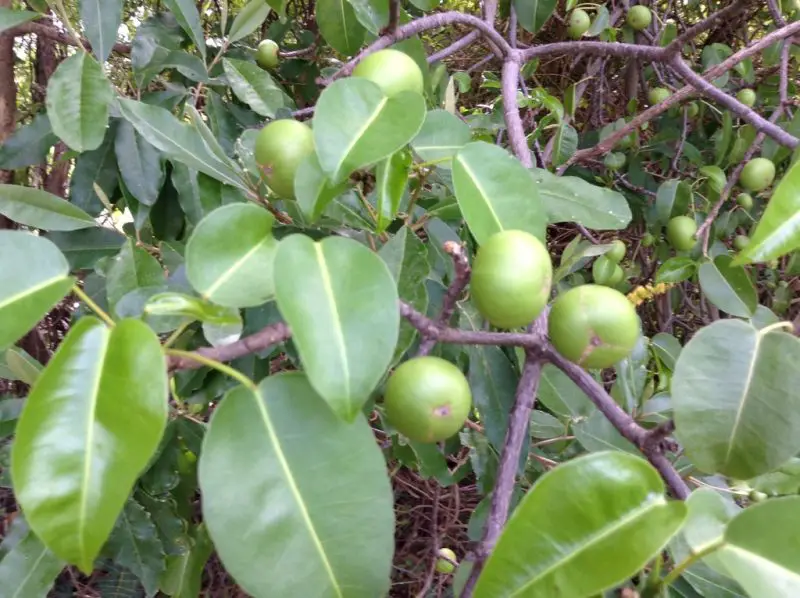
The Manchineel Tree is one of the most poisonous plants in the world and is native to southern Florida, especially along the coasts and in the Florida Keys. This small to medium-sized tree has glossy green leaves and small greenish-yellow fruits that resemble apples. Despite its innocent appearance, the entire tree is dangerously toxic, including the bark, leaves, sap, and fruit.
The tree typically grows to a height of 15 to 30 feet and is often found along sandy beaches, coastal swamps, and mangrove margins. Its fruits, known as “beach apples” or “death apples,” are particularly deceptive and have caused severe poisonings when consumed. The sap is milky white and exudes from damaged bark or broken branches. Even rainwater dripping off the leaves can carry toxins.
The toxic components of the Manchineel Tree include phorbol esters, which cause severe blistering and chemical burns upon skin contact. Eating the fruit can lead to severe mouth, throat, and gastrointestinal burns, nausea, and even death. Standing under the tree during rain can result in skin burns or eye irritation. The smoke from burning its wood is highly toxic and can cause blindness or lung damage.
In Florida, the Manchineel Tree is often marked with warning signs or red paint to alert the public. It is protected in some areas due to its role in coastal ecosystems, despite its toxicity. Visitors to beach areas where the tree grows should be extremely cautious and avoid touching or standing beneath it. Its reputation as one of the deadliest trees is well-earned and serves as a reminder of nature’s hidden dangers.
Coontie (Zamia integrifolia)
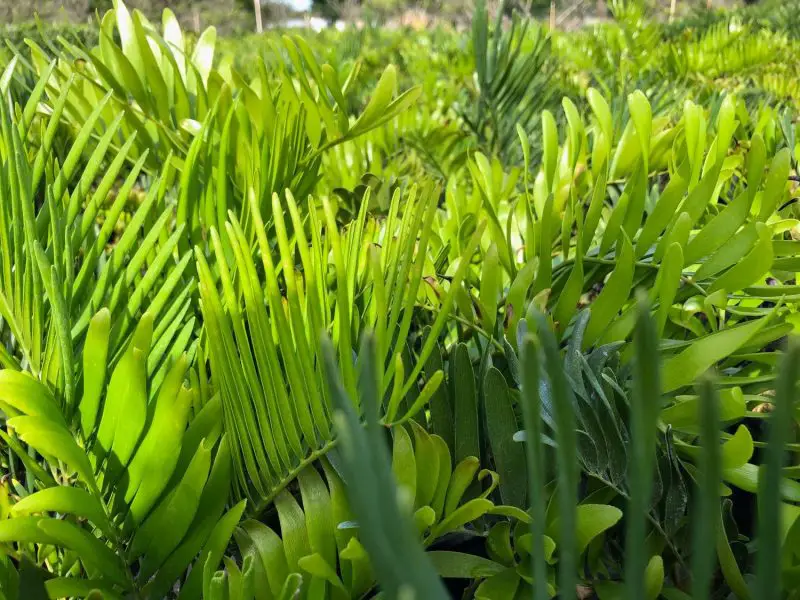
Coontie is a native Florida cycad that resembles a small palm or fern, with stiff, feather-like leaves emerging from a central trunk. It is one of the oldest plant species still existing and thrives in sandy, well-drained soils. This hardy plant is a popular choice in native landscaping due to its drought tolerance and ability to grow in both sun and shade. It can often be found in gardens, pine flatwoods, and scrublands across the state.
The plant is slow-growing and usually reaches 1 to 3 feet in height. Its dark green, leathery leaves form a symmetrical rosette, making it visually appealing in home and commercial landscapes. Male and female plants produce cones, and the female cones develop bright orange seeds that are highly noticeable. Despite its attractive appearance and value to native butterfly species, especially the Atala butterfly, Coontie is not without danger.
Both the seeds and underground rootstocks of Coontie contain cycasin, a potent neurotoxin and carcinogen. Ingestion of even small amounts can lead to severe liver and neurological damage in animals and humans. Dogs are particularly vulnerable, and symptoms may include vomiting, diarrhea, lethargy, seizures, and liver failure. There is no specific antidote, and treatment focuses on managing the symptoms.
Although the plant plays an important role in Florida’s ecology, it must be handled with care. Gardeners should avoid planting it where pets or small children might have access to the seeds. Historically, indigenous people processed the roots into flour, but only after extensive detoxification steps. Today, this process is not recommended, and Coontie remains a plant that must be appreciated with caution.
Lantana (Lantana camara)

Lantana is a flowering shrub known for its clusters of bright blooms in red, orange, yellow, pink, and purple. Widely used in Florida gardens for its color and ability to attract butterflies, Lantana grows well in hot, sunny conditions and poor soils. However, it is also considered an invasive species that aggressively spreads in natural areas, outcompeting native plants and disrupting ecosystems.
The plant can grow from 1 to 6 feet tall and has square stems with rough, toothed leaves. Its flowers are small and tubular, grouped in rounded heads that change color as they age. After blooming, it produces clusters of small green berries that ripen to a shiny black. While birds may eat the ripe berries, they are highly toxic to many mammals, especially children and livestock.
Lantana contains triterpenoids, toxic compounds that can cause vomiting, diarrhea, liver damage, and increased sensitivity to sunlight (photosensitization). In animals like horses, goats, and dogs, ingestion can lead to serious complications, including liver failure and skin lesions. The unripe berries and leaves are especially harmful, and repeated exposure can cause cumulative toxicity.
Despite its ornamental value, Lantana’s risks should not be overlooked. Gardeners should consider planting safer alternatives, especially in homes with children or pets. Regular pruning and removal of berries can reduce risk, but the plant’s invasive nature and toxicity make it a controversial choice for Florida landscapes.
Castor Bean (Ricinus communis)
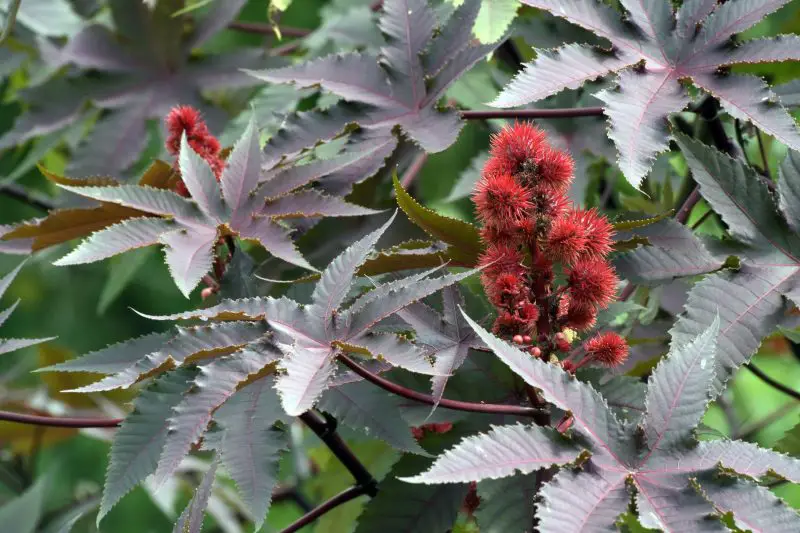
Castor Bean is a fast-growing ornamental plant recognized for its large, star-shaped leaves and colorful seed pods. Often grown for its bold foliage and dramatic appearance, the plant can reach heights of 6 to 10 feet in a single growing season. Its striking red or purple stems and spiny seed capsules make it a unique addition to tropical-style gardens in Florida. However, it harbors one of the deadliest natural toxins known.
The seeds of the Castor Bean plant are shiny, mottled brown and resemble ticks, which is how the plant got its scientific name. Each seed contains a deadly compound called ricin, a toxin that inhibits protein synthesis at the cellular level. Ricin is so potent that ingesting just one or two chewed seeds can be fatal to a child or small pet.
Symptoms of ricin poisoning may include nausea, vomiting, severe abdominal pain, diarrhea, seizures, and multi-organ failure. There is no antidote, and death can occur within 36 to 72 hours of exposure if not treated promptly. Even handling the seeds without gloves can pose a risk if the outer shell is damaged or cracked.
Given the extreme toxicity of Castor Bean seeds, the plant should never be grown in areas accessible to children, pets, or livestock. While it may add visual drama to a garden, the danger it poses far outweighs its aesthetic value. In Florida, it is sometimes found growing wild near disturbed areas, and its presence should be reported or removed safely.
Dumb Cane (Dieffenbachia spp.)
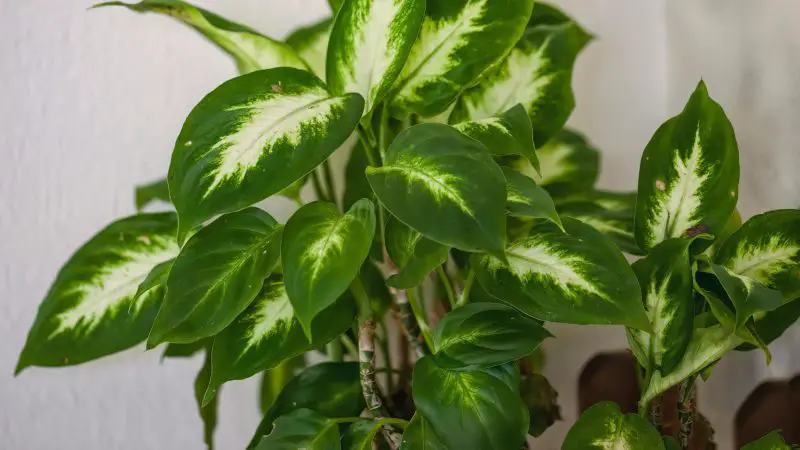
Dumb Cane is a popular houseplant known for its lush green leaves with creamy white or yellow patterns. It is commonly found indoors across Florida due to its ability to thrive in low light and humid environments. The plant’s upright growth habit and tropical appearance make it a favorite for both homes and offices. Despite its widespread use, Dumb Cane can be dangerously irritating if mishandled.
The plant’s leaves and stems contain calcium oxalate crystals, which are sharp, needle-like structures. When chewed or crushed, these crystals penetrate the skin and mucous membranes, causing immediate burning and swelling. Ingestion can lead to severe mouth and throat pain, drooling, nausea, and difficulty speaking—hence the common name “Dumb Cane.”
While fatalities are extremely rare, the symptoms can be alarming and painful, especially for children and pets. In some cases, swelling may block the airway, leading to breathing difficulties that require medical attention. Even touching the sap and then rubbing your eyes can cause intense irritation and temporary vision problems.
Due to its beauty and low-maintenance needs, Dumb Cane remains a popular indoor plant. However, it should be placed out of reach of pets and children, and gloves should be used when pruning or repotting. Knowing how to handle this plant safely is key to enjoying its tropical charm without risk.
Pokeweed (Phytolacca americana)
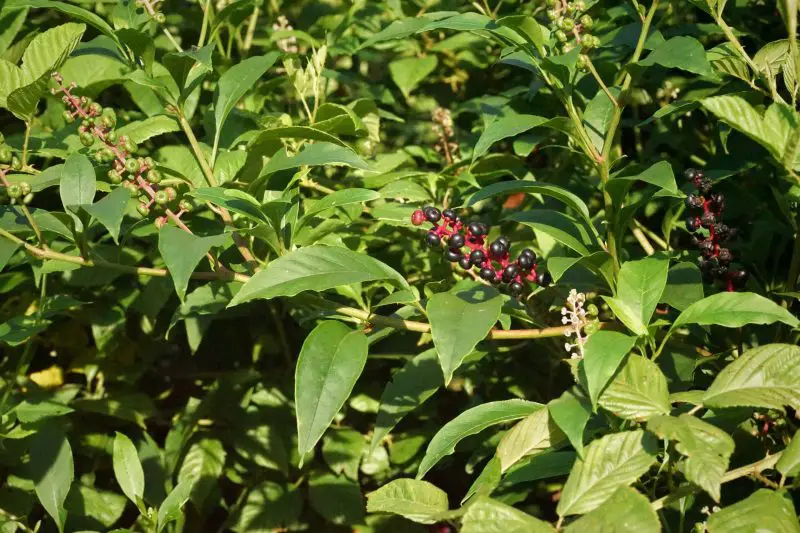
Pokeweed is a tall, herbaceous plant native to the eastern United States and found throughout Florida in open fields, roadsides, and disturbed areas. It can grow up to 10 feet tall and has thick, reddish-purple stems, large lance-shaped leaves, and long clusters of white or green flowers. In late summer and fall, the plant produces drooping clusters of dark purple berries that are visually appealing but deceptively dangerous.
The berries are the most commonly encountered part of the plant and are often mistaken for edible wild fruit by children and foragers. While birds can eat the berries without harm, they are toxic to humans and many animals if consumed raw. The roots, stems, and mature leaves also contain toxic compounds, and all parts of the plant should be considered poisonous.
Pokeweed contains several harmful substances, including phytolaccatoxin and phytolaccigenin, which can cause vomiting, diarrhea, difficulty breathing, seizures, and in severe cases, death. Symptoms may appear within hours of ingestion. The root is especially toxic and has been linked to multiple poisoning cases when used incorrectly in herbal remedies or mistaken for edible roots.
While some people boil young pokeweed shoots in multiple changes of water to make “poke salad,” this practice is risky and not recommended. In Florida, pokeweed is best admired from a distance, and precautions should be taken to prevent accidental exposure. Its fast growth and striking appearance make it common, but its toxic nature requires respect and caution.





